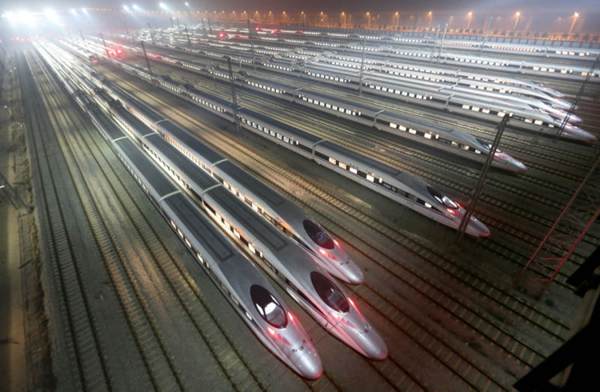

 |
China-U.S. economic and trade deals account for over two thirds on the list of all 49 deals President Xi Jinping sealed during his U.S. State Visit. Among them are joint-ventured company to build a 370-kilometer high-speed rail line linking Southern California to Las Vegas, collaboration between Microsoft and Xiaomi to provide “cloud service” for customers, construction of a manufacturing base in Massachusetts with $60 million investments from CRRC Co., and so on. As two giant economies, China and the U.S. are tightly connected to each other. The trade and economy on high levels are bringing along unlimited business opportunities.
There have been doubts about whether Chinese economy would have a so-called “hard-landing”, or whether the fluctuation in Chinese stock market would influence the direction of China’s reform. “China's economy will stay on a steady course with fairly fast growth”, said President Xi in Seattle. “Opportunities facing the two countries require a deepened China-U.S. trade cooperation.” Echoing all these statements made by President Xi in the State Visit, the achievements made during the past week have sent a clear signal: China will stay on its reform track despite the fluctuations in the market. The Chinese economy has been brought into a new status and will keep the accelerating rate as it steps into a higher level. The future prospect is still bright.
Let the statistics say. Despite the complexity and volatilities of world economy, Chinese economy maintains a 7 percent growth rate in the first half of this year, which is one of the highest in the world.
In the first six months of this year, 7.18 million new jobs have been created in cities and towns, achieving 71.8 percent of the annual goal. The average income rate has grown by 7.6 percent year on year. The two core indices of employment and income have shown the steady growth of Chinese economy.
In the past 8 months, China attracts $85.3 billion of foreign direct investment, seeing a 9 percent increase year on year. This indicates that foreign investors still hold firm confidence in Chinese economy. On the other hand, China has invested in 4862 companies across 150 countries and regions. These overseas investments accumulate to 473.43 billion Chinese Yuan, with an 18.2 percent increase from last year.
The potential of Chinese market is huge with the new industrialization and advancing IT application, urbanization and agricultural modernization. Chinese people are becoming more willing to spend what they have earned through hard work. The middle-class is rising up in China. All of these are the basic facts about Chinese economy.
Time will tell. People know Chinese economy well would see that the current problems are just temporary in economic transformations. The key to solving these questions is reform and opening-up. The upcoming new round of reform is unprecedentedly comprehensive. The 3rd Plenary Session of 18th CPC Central Committee has set guidance for continuing policy reforms. Over 330 points to reform have been raised. The 80 major reform tasks have been mostly finished in 2014. About 70 reform proposals have been raised in the first six months of this year, of which the effects will gradually unveil.
We all know it well that the most imperative problem to solve for China is to the imbalanced, uncoordinated, and unsustainable problems emerged in the development. To evaluate the quality and rewards in Chinese economic growth, strong incentives are needed.
To reform means to change, and changes are often enshrouded with uncertainty. Worries over uncertainty keep Chinese people vigilant in its economic development.
China is trying hard to keep the macro economy stable through practical actions. To tackle the abnormal fluctuations in the stock market, Chinese government curbed the spread of panic and thus avoided a systemic risk. China has also finalized the RMB exchange rate quotation mechanism.
Short-term currency fluctuations might occur, but there is no basis for any continued depreciation. Increasing the intensity of market-determined exchange rate is part of an established market-oriented reform. This has nothing to do with a so-called "currency war". The speculations of stimulating exports for any so-called "quick fix" are ludicrous.
To drive this train named Chinese economy, we do not need to press the accelerator, or to pull the break. Chinese economy will be escalating in a steady way. No nation is isolated in globalization. Win-win, instead zero-sum game, is the right way for economic development.
“The interests of China and the United States are deeply interconnected, and we have greater responsibilities for world peace and human progress,” said President Xi at the joint press conference with President Obama in Washington, D.C.
President Xi’s statement reveals the logic behind the global economic growth. China has a huge economic potential, with leeway and internal strength coming at the same time. China is thus fully able to maintain a high level of long-term economic growth, and to provide a vast market and a solid support for the world economy. An open China will continue to draw strength from the developing world, and the development of China will eventually benefit the world.
Translated from Commentary 《中国经济发展前景依然光明》, published on People's Daily, Sept. 28, 2015

 Construction of HK-Zhuhai-Macao Bridge enters final stage
Construction of HK-Zhuhai-Macao Bridge enters final stage Model of heavy-lift copter makes debuts at Tianjin expo
Model of heavy-lift copter makes debuts at Tianjin expo Art photos of Chinese beauty in Han Chinese clothing
Art photos of Chinese beauty in Han Chinese clothing Stunning photos of air show in China’s V-Day parade
Stunning photos of air show in China’s V-Day parade Models change clothes on street in Hangzhou
Models change clothes on street in Hangzhou Charming Chinese female soldiers
Charming Chinese female soldiers Beauty vs. muscular man
Beauty vs. muscular man World's passenger plane giants convene in Beijing aviation expo
World's passenger plane giants convene in Beijing aviation expo First day in kindergarten
First day in kindergarten On the way
On the way Model village
Model village UK opens bidding for rail contracts
UK opens bidding for rail contracts Muslims in Xinjiang celebrate Corban Festival
Muslims in Xinjiang celebrate Corban FestivalDay|Week